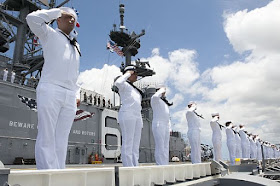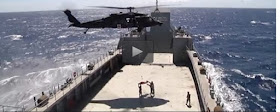 |
| Sailors and Marines manned the rails of USS America as it pulled into Pearl Harbor in preparation for Rim of the Pacific maritime exercise. See more below. Photo from U.S. Navy |
“Harry Kim understands the challenges faced by working families and will work hard to bring opportunities that create good paying jobs and a diversified economy for Hawai`i Island,” union Executive Secretary-Treasurer Ron Taketa said. “We strongly support Harry’s ‘application’ to serve the people of Hawai`i Island again.
 |
| Harry Kim with his wife, son, daughter-in-law and granddaughter. Photo from Harry Kim |
“During Kim’s time as mayor, he set into motion numerous infrastructure projects for roads and highways to improve transportation and traffic flow islandwide, especially for the growing community of West Hawai`i. Kim was also credited with leading Hawai`i Island through bad and good economic times. His creation of the Disaster and Emergency Fund, the Rainy Day funding reserves, and his set aside of nearly $27 million for the unpaid liability of post-retirement benefits for public workers were instrumental to the economic stability of Hawai`i Island in the years following his term as mayor.”
Kim also has received endorsements from Hawai`i Government Employees Association, Sierra Club of Hawai`i and Puna Pono Alliance.
To read comments, add your own, and like this story, see Facebook. Follow us on Instagram and Twitter.
To read comments, add your own, and like this story, see Facebook. Follow us on Instagram and Twitter.
 |
| RIMPAC participants test new equipment. Photo from U.S. Navy |
Through Aug. 4, RIMPAC is hosting 26 nations, with 25,000 personnel, two submarines, some 40 ships and more than 200 aircraft in and around the Hawaiian Islands and Southern California. According to the military, RIMPAC, the world’s largest international maritime exercise, provides training to foster and sustain cooperative relationships critical to ensuring safety of sea lanes and security on the world’s oceans. RIMPAC 2016 is the 25th exercise in the series that began in 1971.
 |
| Ships steam in formation at RIMPAC. Image from USS America |
The amphibious assault ship USS America (LHA 6) conducted a group sail with other countries on its way to RIMPAC. Royal Canadian Navy frigate Her Majesty’s Canadian Ship Vancouver (FFH 331), Chilean Navy frigate CNS Cochrane (FF 05), amphibious transport dock ship USS San Diego (LPD 22) and guided-missile destroyer USS Howard (DDG 83) steamed in formation.
To read comments, add your own, and like this story, see Facebook. Follow us on Instagram and Twitter.
To read comments, add your own, and like this story, see Facebook. Follow us on Instagram and Twitter.
HAWAIIAN VOLCANO OBSERVATORY provides an update on the current lava flow from Pu`u `O`o in the current issue of Volcano Watch.
“Two years ago, Kilauea Volcano`s ‘June 27th’ flow advanced to the northeast, threatening Pahoa and creating major disruptions to thousands of residents in the lower Puna district on the Island of Hawai`i,” the article states. “Today, a new flow from Pu`u `O`o is moving to the southeast along the boundary of Hawai`i Volcanoes National Park and could eventually reach the ocean.
“As Hawai`i residents can appreciate, change is just part of the typical behavior of Kilauea’s ongoing East Rift Zone eruption.
“Two years ago, Kilauea Volcano`s ‘June 27th’ flow advanced to the northeast, threatening Pahoa and creating major disruptions to thousands of residents in the lower Puna district on the Island of Hawai`i,” the article states. “Today, a new flow from Pu`u `O`o is moving to the southeast along the boundary of Hawai`i Volcanoes National Park and could eventually reach the ocean.
“As Hawai`i residents can appreciate, change is just part of the typical behavior of Kilauea’s ongoing East Rift Zone eruption.
“This new lava flow, informally dubbed the “61g” flow after the eruptive episode sequence the USGS Hawaiian Volcano Observatory uses to document Pu`u `O`o flows, began on May 24, 2016. Over the past six weeks it has advanced to the southeast without interruption. The flow has remained relatively narrow and focused, and consists mostly of pahoehoe lava, which is typical of Pu`u `O`o flows in recent years.
“Around June 23, the 61g flow reached the top of the pali (cliff) above the coastal plain and the upper boundary of the abandoned Royal Gardens subdivision, which is almost completely buried by earlier Pu`u `O`o lava flows. As the flow continued to advance, it picked up speed on steep sections of the pali, forming impressive `a`a lava channels on the slopes.
“Within a few days, the flow front reached the base of the pali and began its advance across the coastal plain. There, the flow front narrowed even more, perhaps because it was confined by nearby high ground created by earlier Pu`u `O`o flows. This focusing of the flow probably contributed to its high advance rate on the coastal plain.
“The 61g flow front initially moved across the coastal plain at a rate of up to 600 meters (about 0.4 miles) per day, which is fairly rapid compared with other Pu`u `O`o pahoehoe flows. As of mid-day on July 7, the flow front was about 1.2 km (0.7 mi) from the ocean, and still moving at a good clip. Given the flow’s current advance rate, lava could reach the ocean for the first time since August 2013 in the coming days or weeks. However, the flow’s advance could slow, spreading lava across the coastal plain rather than into the ocean, or it could stall.
“Compared to the June 27th flow, which threatened Pahoa and nearby subdivisions, the location of the 61g lava flow presents no immediate hazard to residential areas. It is currently overrunning older Pu`u `O`o lava flows a safe distance from the nearest homes.
“Although the hazard to property has diminished, the potential hazard to people is greater now that the flow is more accessible. The opportunity to see an active lava flow is already drawing hundreds of visitors hoping for a glimpse of lava to Kilauea’s south coast.
“Besides the obvious dangers of molten lava (burns, exposure to fumes), hiking to a lava flow is risky for a number of reasons, including the possibility of falling on the rough, uneven terrain, becoming dehydrated, or suffering heat exhaustion or stroke. Heat from above (the sun) and below (hot ground) can rapidly overwhelm even the strongest of hikers. Proper gear –sturdy hiking boots, long pants, gloves, sun protection – and lots of water are essential for safe hiking.
“If lava reaches the sea and forms an ocean entry, new hazards will appear. In general, ocean entries are the most dangerous part of a lava flow field due to unpredictable bench collapses, explosions, and scalding steam plumes. This danger is not theoretical – several people have died near Kilauea ocean entries in years past.
“To safely view the 61g flow, your best plan is to get up-to-date lava-viewing information from Hawai`i Volcanoes National Park (https://www.nps.gov/havo/planyourvisit/lava2.htm) and the County of Hawai`i (http://www.hawaiicounty.gov/lava-viewing/). These agencies have outlined where and when safe lava viewing is available.
“The U.S. Geological Survey offers information on viewing lava safely in an online Fact Sheet (http://pubs.usgs.gov/fs/2000/fs152-00/fs152-00.pdf). Because it was published in 2000, the map is out of date. However, the hazard information and safety tips provided in the Fact Sheet are timeless and relevant.
“Compared to the June 27th flow, which threatened Pahoa and nearby subdivisions, the location of the 61g lava flow presents no immediate hazard to residential areas. It is currently overrunning older Pu`u `O`o lava flows a safe distance from the nearest homes.
“Although the hazard to property has diminished, the potential hazard to people is greater now that the flow is more accessible. The opportunity to see an active lava flow is already drawing hundreds of visitors hoping for a glimpse of lava to Kilauea’s south coast.
“Besides the obvious dangers of molten lava (burns, exposure to fumes), hiking to a lava flow is risky for a number of reasons, including the possibility of falling on the rough, uneven terrain, becoming dehydrated, or suffering heat exhaustion or stroke. Heat from above (the sun) and below (hot ground) can rapidly overwhelm even the strongest of hikers. Proper gear –sturdy hiking boots, long pants, gloves, sun protection – and lots of water are essential for safe hiking.
“If lava reaches the sea and forms an ocean entry, new hazards will appear. In general, ocean entries are the most dangerous part of a lava flow field due to unpredictable bench collapses, explosions, and scalding steam plumes. This danger is not theoretical – several people have died near Kilauea ocean entries in years past.
“To safely view the 61g flow, your best plan is to get up-to-date lava-viewing information from Hawai`i Volcanoes National Park (https://www.nps.gov/havo/planyourvisit/lava2.htm) and the County of Hawai`i (http://www.hawaiicounty.gov/lava-viewing/). These agencies have outlined where and when safe lava viewing is available.
“The U.S. Geological Survey offers information on viewing lava safely in an online Fact Sheet (http://pubs.usgs.gov/fs/2000/fs152-00/fs152-00.pdf). Because it was published in 2000, the map is out of date. However, the hazard information and safety tips provided in the Fact Sheet are timeless and relevant.
“From home, you can track the progress of Kilauea’s lava flow through daily eruption updates and recent maps and photos posted on the USGS Hawaiian Volcano Observatory website (http://hvo.wr.usgs.gov/).”
 |
| Dr. David Davenport practiced at Ka`u Hospital. Image from Volcano Art Center |
To read comments, add your own, and like this story, see Facebook. Follow us on Instagram and Twitter.
TODAY IS THE LAST DAY to view Ka`u & Kilauea Reflections. The exhibit of paintings and pottery by former Ka`u Hospital Dr. Douglas Davenport raises funds for its Charitable Foundation. Nona Wilson, the hospital’s former Director of Nursing, presents the exhibit at Volcano Art Center in Volcano Village until 3 p.m.
CASSANDRA CUPPLES EXPLAINS what acupuncture is and what conditions it treats tomorrow at 3 p.m. at Na`alehu Library and Tuesday at 6 p.m. at Pahala Library.
Call 939-2442 and 928-2015 for more information.
 |
| Hokualaka`i Photo from Polynesian Voyaging Society |
KA`U RESIDENTS ARE INVITED to the beach at Hilo’s Palekai (Radio Bay) in Keaukaha for a ceremony tomorrow at 9:30 a.m. The Department of Transportation will officially give the double-hull voyaging canoe Hokualaka`i a home there. Members of the nonprofit group Perpetuating Unique Educational Opportunities are working to restore the canoe as a teaching vessel.
WHAT’S BUGGIN’ THE MOUNTAIN? That’s the question answered Tuesday at 7 p.m. at Kilauea Visitor Center Auditorium in Hawai`i Volcanoes National Park. The alpine and subalpine environments on Maunakea support a diversity of native and endemic insects. Heather Stever and Jessica Kirkpatrick present their thesis research on the diversity of insects on different plant types in Maunakea’s subalpine community and the distribution of wekiu bugs on cinder cones in the alpine stone desert.
Free; park entrance fees apply.
Free; park entrance fees apply.
SUPPORT OUR SPONSORS AT PAHALAPLANTATIONCOTTAGES.COM AND KAUCOFFEEMILL.COM. KA`U COFFEE MILL IS OPEN SEVEN DAYS A WEEK.
 |
| See kaucalendar.com/KauCalendar_July_2016.pdf. |
 |
| See kaucalendar.com/TheDirectory2016.pdf. |



